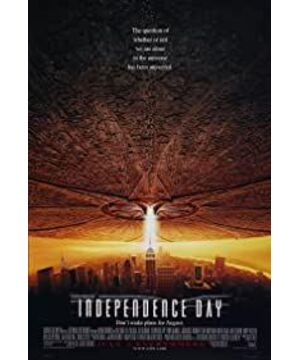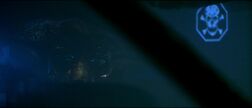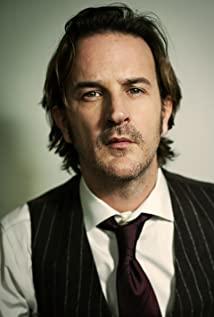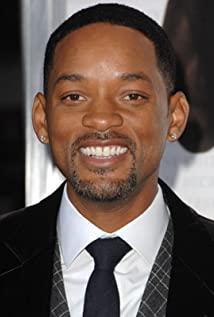When Roland Emmerich and his screenwriter partner Dean Devlin promoted their new film "Stargate" in Europe, a reporter asked Emmerich why he did not believe in the existence of aliens. Make movies like "Stargate". Emmerich said that he was still fascinated by the idea of aliens coming, and further asked reporters to imagine when they woke up early in the morning and found an alien spacecraft up to 15 miles wide over major cities in the world. After speaking, he immediately said to Devlin next to him: "I think I already have an idea for our next movie."
Sometimes, the idea of a movie is so sudden. On July 2, 1996, Emmerich’s aura suddenly became a reality, and "Independence Day" was released in the United States, which coincided with the date when the alien spacecraft in the film arrived on Earth. As a result, the film set several records in succession, first breaking the record of Joe Schumacher’s "Batman Forever" with a three-day release of 52.8 million U.S. dollars, and then breaking Spielberg with a seven-day revenue of 100 million U.S. dollars. "Jurassic Park" set a record of $100 million in nine days in 1993. In the end, "Independence Day" used a cost of 75 million U.S. dollars to win the global box office of 817 million U.S. dollars. The high box office and the sensation of effect are all phenomena.
To say that the most impressive part of the film is the spectacular and magnificent visual effects. The Oscar for the best visual effects can be said to be well-deserved. Tall buildings burst, vehicles rolled over, and the city burned, not to mention the oppressive feeling brought by the huge spacecraft that obscured the sky. The most classic scene is undoubtedly that a light beam emitted by a spacecraft directly hits the White House. This scene is also used as a key promotional still photo for the film's marketing activities, achieving a very good eye-catching effect.
Originally, Emmerich planned to use pure computer CGI to create special effects, but the effect was not ideal. So not only did they spend huge sums of money to make miniature models of cities such as Washington, New York, and Los Angeles, but also invited props to make models of buildings such as the White House, Statue of Liberty, and Capitol. Then these models were placed on the stand, detonated the gunpowder under it, and filmed with a high-speed camera, only then did the audience see the shocking and lifelike scenes.
However, the idea of aliens invading the earth was not first created by Emmerich. As early as the 1950s, there were three films that met this definition-"Weirdo", "The Day the Earth Stood Still" and "World War", and these three films were remade one by one in the future ( They are Carpenter's "Weird Shapes", Derrickson's "The Day the Earth Stood Still" and Spielberg's "World War"). But after that, stalks such as "Alien Invasion" gradually ceased to be popular, and sci-fi genre films were taken by "Star Wars" to a more distant and profound universe. "Like Contact" this kind of warm and friendly direction. In contrast, "Independence Day" took a serious retro road full of fear, distrust and confrontation.
However, since the pilot played by Will Smith, Shearer, captured an alien, the solemn and peculiar "blockbuster" atmosphere established in the early part of the film has begun to dissipate. Area 51 can be there, but can the researchers in it not be so funny? As for the octopus-like aliens, they are not only old-fashioned in appearance, but also unknown. It is even more logical that the mothership, which is a quarter of the moon, is not used, and the beam cannon that can blast off the White House and the Empire State Building is not used. Instead, some small spacecraft are sent to fight with the US Air Force. Judging from these rough settings, it is almost at the level of a low-cost B-grade film.
What changed my impression the most during this review is the ideology conveyed by the film. Looking at the racial and class settings, blacks are low-level military officers, girlfriends are strippers; Jews are divorced scientists with no ambitions; and the president is naturally white, and the husband and wife are happy and the family is happy. Although the first lady is seriously injured and killed, it is a plot. need. Look at the number of appearances of the American flag in the film, from the moon, to cars, to monuments, and even the background of the stripping stage is also the American flag.
But the most concentrated episode is the president’s pre-war speech: "The word human has a new meaning for us. We can no longer kill each other for trivial things, we must unite for the common good... You To fight for freedom again, not to resist tyranny or persecution, but to avoid being wiped out, but to fight for the power to survive, to fight for survival." This paragraph is fairly high-sounding, but afterwards, the conversation turns, "If you can win, July 4th will no longer be just a holiday in the United States, but a day when the world will swear an oath.” There is a strong taste of American ideological chicken soup. Hollywood's industrialized movies contain ideology everywhere, but such straightforward metaphors of the United States as the God who saves all mankind are rare, which is very disgusting. Compared with that, the uncle drunkard who was still cursing his mother, driving a plane and disappearing with the alien spacecraft came more crispy.
Despite some shortcomings of this kind, in that era, "Independence Day" was still regarded as an important turning point in Hollywood movies, and opened a category of disaster genres featuring CGI special effects and mass destruction events. For example, in 1998, two disaster films "The End of the World" and "Clash between Heaven and Earth" were released in succession. And Roland Emmerich has also become a leader in disaster films, embarking on the path of professional destruction.
Looking at the three major male protagonists, Bill Pullman, who played the president, was not very successful in his career. He always mingled in low-cost works or played some supporting roles; Jeff Goldblum, who played the scientist, often played the role by virtue of his coquettish and evil spirit. Some maverick characters also have a certain exposure rate; the best mixed is of course Will Smith, who made two consecutive hit movies in "The Jedi Men" in 1995 and "Independence Day" in 1996. Under the blessing, he suddenly rose to the rank of first-line celebrities, and he was especially popular with science fiction and action movies. The sound of "Historical Emperor" represents the qualifications and fans' love for him.
♑
View more about Independence Day reviews











